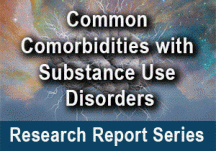Co-Occuring Mental Health Disorders
Many women with substance use disorders are also diagnosed with other mental disorders. This is important because interactions between illnesses can worsen the course of both. Patients who have both a substance use disorder and another mental health condition often have symptoms that are more persistent, severe, and resistant to treatment compared with patients who have either disorder alone. Both disorders should be treated at the same time to improve the likelihood of success. Although men are more likely than women to report both a mental health and substance use disorder within the past year,13 women are more likely to suffer from certain mental health conditions, such as depression,176 anxiety, post-traumatic stress disorder (PTSD),177 and eating disorders.178 Some women report using substances to relieve stress or negative emotions.179–181 In addition, women are more vulnerable to developing substance use or other mental health disorders following divorce, loss of child custody, or the death of a partner or child.10
Women, Violence, and Substance Abuse
More than 1 in 3 women have experienced physical violence at the hands of an intimate partner, including a range of behaviors from slapping, pushing, or shoving to severe acts such as being beaten, burned, raped, or choked.182 Victims of violence are at increased risk of chronic health conditions, including obesity, chronic pain, depression, and substance use.183 In recognition of the severity of violence against women and the need for a national strategy to address this issue, in 1994 Congress enacted the Violence Against Women Act to hold offenders accountable and to provide services to victims.184 In 2013, President Obama reauthorized the Act to expand programs for reaching especially vulnerable populations.185
The Institute of Medicine and the U.S. Preventive Services Task Force (USPSTF) have recommended that clinicians screen and counsel for interpersonal violence. To help meet that need, the Affordable Care Act of 2010 (Section 2713) requires that health insurance providers cover all preventive services recommended by the USPSTF without copays or deductibles. However, improved prevention and screening guidelines are needed to help clinicians identify those who need help and link them to the care they need.186
Race and Ethnicity
Women of color may face unique issues with regard to drug use and treatment needs. For example, African-American and American Indian/Alaska Native women are more likely than women of other racial and ethnic groups to be victims of rape, physical violence, and stalking by an intimate partner in their lifetime. As discussed above, these issues are risk factors for substance use and should be addressed during treatment.

